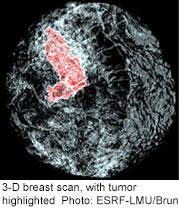
MONDAY, Oct. 22 (HealthDay News) — Scientists have developed a new technique to produce 3-D images of breast tissue that they say are two to three times sharper than current hospital CT scans with a lower radiation dose than is delivered currently by conventional mammograms.
“Mammography relies on two-dimensional images,” said Jianwei Miao, professor of physics and astronomy at the University of California, Los Angeles, and a researcher with the university’s California NanoSystems Institute.
That may help explain why 10 percent to 20 percent of breast tumors go undetected on mammogram, Miao said.
CT scans are also three-dimensional, Miao said, but are not considered useful for detecting breast cancer, as it requires a larger dose of radiation than a mammogram.
To improve detection of breast cancer, Miao, working with UCLA colleagues and German scientists, developed ”a new way to visualize human breast cancer in three dimensions with a radiation dose somewhat lower than that in current mammograms.”
To develop the new technique, Miao’s team combined a type of X-ray imaging with an image-reconstruction method known by scientists as “equally sloped tomography.” One reason the technique may be better for detection is that it measures the difference in the way an X-ray oscillates through normal breast tissue compared to tissue with cancer, the scientists said.
Five independent radiologists have now evaluated the method. They found that it can reduce the radiation dose by about 74 percent compared to conventional methods. It produced images with the highest image quality compared to 3-D images of breast tissues captured through other standard methods.
The report of the technique and evaluation appeared Oct. 22 in the online edition of the journal Proceedings of the National Academy of Sciences.
The technique won’t be available to patients for some time, Miao said.
“Before our technique is available, we need a more advanced X-ray source,” he said. The equipment for that source is available now only in large-scale research lab environments.
The X-ray source needs to be smaller so it can fit easily into a hospital or clinic room, he said. It could be a decade or more before the 3-D technique is clinically available.
Any technique that would lower radiation doses from mammograms would be good, said Dr. Debra Monticciolo, chairwoman of the American College of Radiology Quality and Safety Commission.
But she, too, cautioned that the technique is still in the research phase.
“The clinical equipment to develop these 3-D images is not currently available,” she said. “It hasn’t been developed yet.”
Mammograms performed on modern equipment deliver very low doses of radiation, according to the American Cancer Society. For one mammogram, the dose is about 0.1 to 0.2 rads, a measure of radiation. To put that in perspective, that is about the same amount of radiation a woman would receive flying coast to coast on a commercial airplane, according to the society.
More information
To learn more about mammograms, visit the American Cancer Society.

